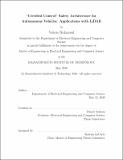"Certified Control" safety architecture for autonomous vehicles : applications with LiDAR
Author(s)
Richmond, Valerie(Valerie G.)
Download1193028983-MIT.pdf (3.223Mb)
Other Contributors
Massachusetts Institute of Technology. Department of Electrical Engineering and Computer Science.
Advisor
Daniel Jackson.
Terms of use
Metadata
Show full item recordAbstract
Certified control is a safety architecture for autonomous vehicles, in which a safety monitor checks actions proposed by the main controller before they may be executed by the actuators. Unlike conventional runtime monitors, the certified control monitor receives an argument for the safety of the proposed action from the controller (rather than receiving data from the vehicle sensors directly). In this architecture, the monitor has the potential to do all of the following to a reasonable degree: intervene when safety is compromised, not intervene when safety is not compromised, and remain simple enough to be verifiable. First, this work describes the certified control architecture in detail, including how it achieves those three desiderata, which we argue are otherwise difficult to achieve simultaneously. Second, we present two novel applications of certified control: an implementation of LiDAR-based obstacle detection, and a LiDAR-augmented implementation of visual lane following. Finally, we evaluate those two systems using simulation and a physical robot car, and demonstrate that they indeed achieve the three desiderata.
Description
Thesis: M. Eng., Massachusetts Institute of Technology, Department of Electrical Engineering and Computer Science, May, 2020 Cataloged from the official PDF of thesis. Includes bibliographical references (pages 61-64).
Date issued
2020Department
Massachusetts Institute of Technology. Department of Electrical Engineering and Computer SciencePublisher
Massachusetts Institute of Technology
Keywords
Electrical Engineering and Computer Science.